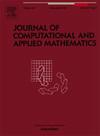Third order two-step Runge–Kutta–Chebyshev methods
IF 2.1
2区 数学
Q1 MATHEMATICS, APPLIED
Journal of Computational and Applied Mathematics
Pub Date : 2024-09-26
DOI:10.1016/j.cam.2024.116291
引用次数: 0
Abstract
The well-known high order stabilized codes (such as DUMKA and ROCK) have several drawbacks: numerically obtained stability polynomials (which do not have a closed analytic form), poor internal stability and convergence. RKC-type methods have much better computational properties. However, these types of methods currently have a second order maximum. In this paper, a family of third order stabilized methods with an explicit analytical solution of stability polynomials is presented. This was made possible by usage of two-step Runge–Kutta methods. A new code TSRKC3 is proposed, illustrated by several examples, and compared to existing programs.

三阶两步 Runge-Kutta-Chebyshev 方法
众所周知的高阶稳定代码(如 DUMKA 和 ROCK)有几个缺点:数值获得的稳定多项式(没有封闭的解析形式)、内部稳定性和收敛性差。RKC 类方法的计算性能要好得多。然而,这类方法目前只有二阶最大值。本文提出了一系列三阶稳定方法,这些方法具有明确的稳定多项式解析解。这是通过使用两步 Runge-Kutta 方法实现的。本文提出了一种新代码 TSRKC3,并通过几个例子进行了说明,还与现有程序进行了比较。
本文章由计算机程序翻译,如有差异,请以英文原文为准。
求助全文
约1分钟内获得全文
求助全文
来源期刊
CiteScore
5.40
自引率
4.20%
发文量
437
审稿时长
3.0 months
期刊介绍:
The Journal of Computational and Applied Mathematics publishes original papers of high scientific value in all areas of computational and applied mathematics. The main interest of the Journal is in papers that describe and analyze new computational techniques for solving scientific or engineering problems. Also the improved analysis, including the effectiveness and applicability, of existing methods and algorithms is of importance. The computational efficiency (e.g. the convergence, stability, accuracy, ...) should be proved and illustrated by nontrivial numerical examples. Papers describing only variants of existing methods, without adding significant new computational properties are not of interest.
The audience consists of: applied mathematicians, numerical analysts, computational scientists and engineers.

 求助内容:
求助内容: 应助结果提醒方式:
应助结果提醒方式:


